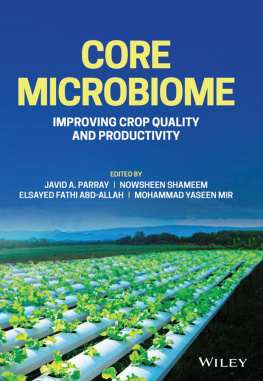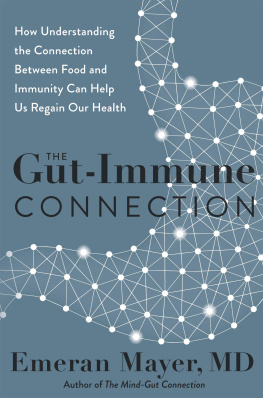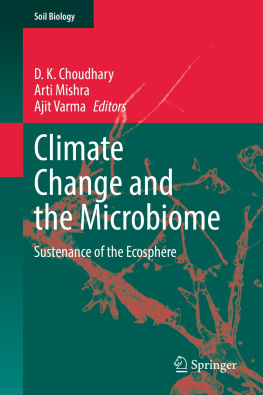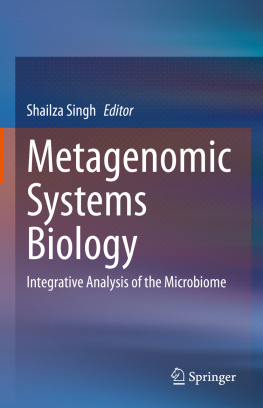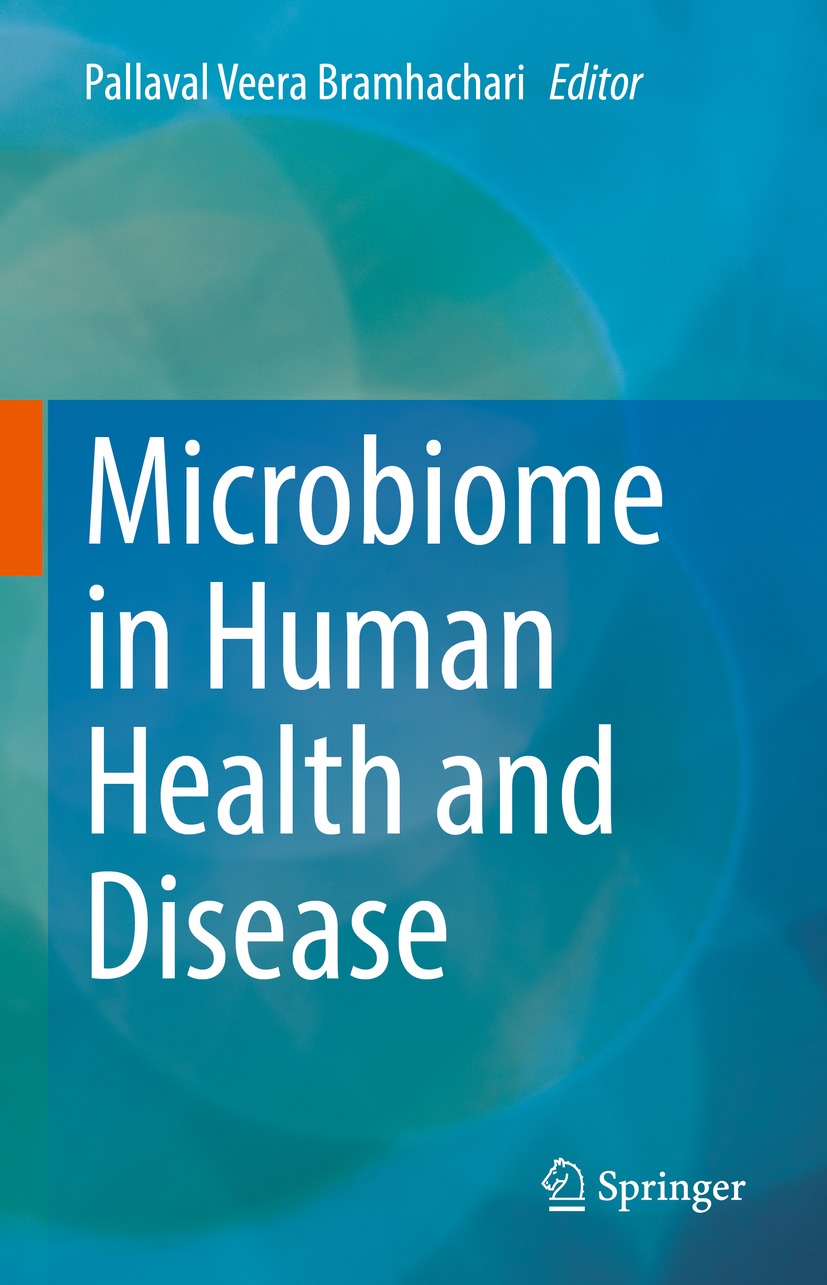Editor
Pallaval Veera Bramhachari
Microbiome in Human Health and Disease
1st ed. 2021

Logo of the publisher
Editor
Pallaval Veera Bramhachari
Department of Biotechnology, Krishna University, Machilipatnam, Andhra Pradesh, India
ISBN 978-981-16-3155-9 e-ISBN 978-981-16-3156-6
https://doi.org/10.1007/978-981-16-3156-6
The Editor(s) (if applicable) and The Author(s), under exclusive license to Springer Nature Singapore Pte Ltd. 2021
This work is subject to copyright. All rights are solely and exclusively licensed by the Publisher, whether the whole or part of the material is concerned, specifically the rights of translation, reprinting, reuse of illustrations, recitation, broadcasting, reproduction on microfilms or in any other physical way, and transmission or information storage and retrieval, electronic adaptation, computer software, or by similar or dissimilar methodology now known or hereafter developed.
The use of general descriptive names, registered names, trademarks, service marks, etc. in this publication does not imply, even in the absence of a specific statement, that such names are exempt from the relevant protective laws and regulations and therefore free for general use.
The publisher, the authors and the editors are safe to assume that the advice and information in this book are believed to be true and accurate at the date of publication. Neither the publisher nor the authors or the editors give a warranty, expressed or implied, with respect to the material contained herein or for any errors or omissions that may have been made. The publisher remains neutral with regard to jurisdictional claims in published maps and institutional affiliations.
This Springer imprint is published by the registered company Springer Nature Singapore Pte Ltd.
The registered company address is: 152 Beach Road, #21-01/04 Gateway East, Singapore 189721, Singapore
Foreword
The microbial world is largely invisible to the human eye, but it is almost beyond imagination. There are hundreds, thousands of different kinds of bacteria (leaving aside other kinds of microbes: archaea, viruses, fungi, and protists), living in every possible environment including deep seabed, high in the clouds, and in the boiling hot springs. Multicellular organisms created an entirely new set of habitats, in and on all those animals and plants.
Research data suggested that during the last two decades, extensive research has been carried out on endophytic fungi and several biologically active compounds have been isolated from endophytic fungi. This book makes all the readers generally conversant in the language of microbiomes and metagenomics. It also provides excellent examples of how microbial communities affect health and cure diseases and dole out typical practical examples of how medical interventions interact with the microbiome and change outcomes.
Understanding the HostMicrobiome Interactions in Human Health. The volume published by the Springer Nature Biomedicine is an important volume, and I strongly believe that it will attract readers working in the field. The present volume has 14 chapters contributed by diversified academicians and scientists working on microbiome research throughout the world. I must congratulate the editor of this book for bringing out this volume with excellent contributions from the most talented scientists working on microbiome research and their applications in understanding the host microbiome interactions in human health.
K. B. Chandra Sekhar
Preface
The human body is a beautifully complex system, hosting trillions of microbial cells that colonize epithelial surfaces such as those present in the mouth and gut are included. There is growing evidence that these microbiomes, which play important roles in human physiology and organ development, do more than just lie on tissues. Indeed, relative to our human genome, there are 100 times more genes in our microbiome and these microbial genes code for proteins that affect different processes such as digestion, immunity, and development. The purpose of this book is to provide a summary of human microbial diversity and to explain attempts to connect microbial communities to human beings.
The Human Microbiome Project (HMP) projects in the USA, Canada, Europe, and Asia have provided a boost to attempt to understand human-associated microbial populations. More than $200 million has been invested by the NIH in the Western World to fund these studies, which are rising now with the introduction of evidence and a flurry of publications. This is a time of extraordinary breakthroughs, and the area is sufficiently mature, while still new to merit a book highlighting advancement. Responses to several issues are appearing now. How do various microbial populations vary across locations in the body? What is the heterogeneity of microbial composition at the same specific location in stable and diseased humans?
To maximize well-being and mitigate disease risk, how can microbial populations be manipulated? Over the course of human evolution, how do microbial populations change? What are the internal factors (genetic, anatomical, hormonal, and physiological) and external environmental factors that form human-associated microbial communities (diet, sexual behavior, and hygiene)? Many additional concerns regarding the personal interactions between human and microbial cells in the body come with partial answers to these questions. The researchers continue to make noteworthy and exhilarating contributions to our understanding of the basic biology of human health in the area of microbiome.
Yet the practical translational applications of this fascinating and enthralling area of science are outstanding. The book also discusses that research on microbiomes provides a more comprehensive view of the genetics of humans and other species, and how it can include innovative human health treatments and new techniques. For the beginner and microbiome enthusiasts, this book may be an essential reading of its importance with existing applications in medicine, agriculture, and climate. With these aims in mind, the material of this textbook has been structured from basic to more advanced topics in a sequential progression. Finally, this book also reviews advancement from fundamental research to relationships between immunemicrobiomes and human health microbiomes: clinical applications.
We hope that your creativity is inspired by this book and wish you luck in your experiments. This book illustrates astonishingly the urgency with which the numerous scientific brains are committed to the welfare of the scientific world. I am immensely grateful to the contributors for consistently paying attention to my request and expressing confidence in my skills. I will still be forever highly obliged to all the contributors forever. The worthlessness of their efforts cannot be explained by these terms.
Because of the heartfelt interest and painstaking effort of many other well-wishers whose names are not listed, but they are already in our hearts, we have effectively compiled our innovative and reflective research work. So, the reward for their sacrifices is definitely worth it. I want this book to be devoted to my mum, S. Jayaprada (late). From the bottom of our souls, I and the contributing authors hope this book will be a good guide and guidance for scientific studies to understand the host microbiome relationships in human health.




